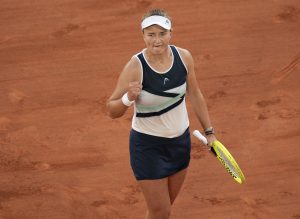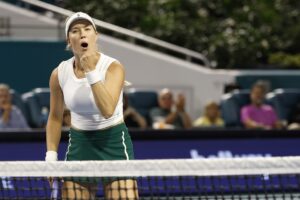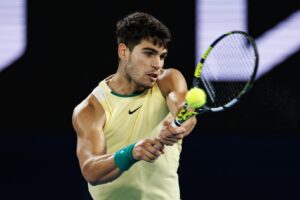For a long time, tennis fans’ eyes were on Denis Shapovalov. Ever since Montreal 2017, where he upset Juan Martin del Potro and Rafael Nadal in succession, the tennis universe thought that Denis Shapovalov was the next big star, set to challenge players such as Alexander Zverev for the #1 ranking in future years.
Shapovalov’s game is based on power and risk. He takes huge cuts at his groundstrokes, and when firing, his lefty forehand and one-handed backhand are amongst the toughest shots to handle in the game. Because, when he is serving well and his groundstrokes are on point, he can almost completely take opponents’ time away and completely dictate play. That is what he did to del Potro and Nadal in Montreal in 2017. Shapovalov made two greats of the game feel very uncomfortable and not in their comfort zones (https://www.youtube.com/watch?v=w-8zAjP0Fys).
However, because risk is such an important component to Shapovalov’s game, there are many days when his game does haywire. Unforced errors can cascade off of the Canadian’s racquet and when Shapovalov is not playing well, viewers have that sinking feeling during rallies than an unforced error is merely a groundstroke away.
This week in Madrid, Shapovalov’s erratic game was prominent once more. He hit four double faults, his first serve percentage was at only 54% and he won fewer than 60% of points on his first and second serve, along with less than 40% on both first and second serve. In addition, Shapovalov was broken three times in two sets and faced nine break points. He lost the match 6-2 7-6(7).
fellow Canadian
What makes this loss more notable than just any first round loss is due to Shapovalov’s opponent. Shapovalov took on fellow Canadian rising star Felix Auger-Aliassime, who is only 18 years old. Auger-Aliassime has been rapidly rising up the rankings in recent months, making the final in Rio de Janeiro, beating Stefanos Tsitsipas in Indian Wells, and qualifying for and making the semifinals of Miami.
Clearly Auger-Aliassime is on the rise, and he is inching closer to Shapovalov in the live rankings at #29, while Shapovalov is at# 21. The ATP Race to London is more telling, however, with Auger-Aliassime at #13 in the ATP Race to London, while Shapovalov sits at #21. Another young Canadian is coming for Shapovalov, and if their Madrid first round encounter is any indicator, Auger-Aliassime will be passing Shapovalov soon.
The loss to Auger-Aliassime was the fourth loss in a row for Shapovalov, and he has yet to record a clay win this year in three tries. His recent couple losses to Auger-Aliassime and Christian Garin are particularly pronounced because they are both two younger players making breakthroughs this season on the tour, while Shapovalov can’t quite gain momentum. The Sunshine Double, in which Denis won six of eight matches, feels worlds away at this point.
Moving forward
Now, this is not an article that is meant to ring the alarm bells and claim that Shapovalov is going to fall off the face of the earth. His game is naturally suited for faster surfaces, where his hard-hitting groundstrokes and lefty serve can do lots of damage.
But, the clay court season is a large portion of the tour, and Shapovalov did show, at least, in the fast conditions of Madrid to be a threat in the past. Last year, he made the semifinals of Madrid, and the high altitude conditions should, theoretically, be better for his game.
Therefore, the loss to Auger-Aliassime is concerning on a couple different levels. First, the fact that he lost to a player younger than him, not to mention a player from his own country and who was in the shadows of Shapovalov just 18 months prior. And second, the fact that even though he was in the higher altitude conditions that previously gave him success, he was unable to find any success on the clay.
Now, it’s very important to emphasize that his three losses were to very high caliber clay courters. All three of Jan-Lennard Struff, Christian Garin, and Felix-Auger Aliassime are high quality opponents whose clay court games are very pronounced. However, given where Shapovalov was during Madrid and during his US Open Round of 16 run from qualifying, even his Madrid semifinals run last year, one would expect better from Shapovalov at this point in his career.
One would expect that Shapovalov would have a better handle of clay court tennis now in order to at least win a match or two at this point on clay. But, unless Shapovalov plays with more controlled aggression, as opposed to his current wild groundstrokes on clay, then he is going to struggle mightily for the rest of his career on the surface. And, unlike Roger Federer, Shapovalov is not good enough to punt on the clay court season and still be a top player.
winning on clay
Clay court tennis is about playing the percentages. There is a reason why Rafael Nadal’s loopy forehand, sailing with topspin high over the net, is so effective on this surface. Margins and putting opponents in uncomfortable positions are so important on the dirt. But, if one is playing low-margin, inconsistent tennis, then opponents feel at ease and less threatened than, for instance, taking on ultra-consistent, counterpuncher 22 year-old Jaume Munar. Whereas, on hard courts and grass, Shapovalov would easily be more dangerous than Munar.
Clay court tennis is about grit more than flash. So, while a jumping backhand might be cool to watch, and could win Shapovalov the point, on clay the war is generally won by those valuing consistency and controlled aggression over hot shots (https://www.youtube.com/watch?v=On3dtNm62c4).
Shapovalov can make a few changes to his game in order to match young opponents such as Garin and Auger-Aliassime in their clay court prowess. He could increase the margin his groundstrokes go over the net and hit to bigger targets. In addition, Shapovalov could also focus less on his serve winning him points, and more on his serve setting himself up to win points shortly thereafter. Rafael Nadal’s lefty serve on clay isn’t coming in like a rocket, but, it does consistently produce shorter returns, which then allows Nadal to step up into the court to punish opponents and put the point away. Shapovalov can do something similar, but it’s dependent on smart serving, as opposed to hard serving.
It could do a lot of good for Shapovalov to go and ask for a clay court Challenger wild card. There are many clay court Challenger tournaments on tour, and this would give him a way to work on his game, without the pressure of playing in an ATP main tour environment, and playing against lower-ranked opponents.
It’s clear that Denis Shapovalov and Felix Auger-Aliassime are close friends.
— Tennis Canada (@TennisCanada) May 6, 2019
But, if Shapovalov wants to keep up with Auger-Aliasssime on clay courts, then tactical changes are necessary in order for Shapovalov to continue improving his game on the dirt.
Main Photo via Getty






